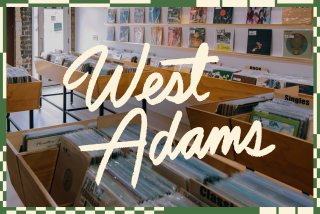TUSTIN : Efforts to Replace Siding Sidetracked
- Share via
When George Santori bought his 1924 Colonial Revival house two years ago, he never dreamed that replacing the siding would be so difficult.
Because Santori’s home lies within the city’s historical district, he needs a “certificate of appropriateness” to do the work. And regular old siding, Santori found out, isn’t appropriate.
When Santori needed new siding, he bought 6-inch-wide Masonite to replace the existing 3-inch redwood slats. The old-style siding is no longer manufactured, and having it custom made would probably have cost at least three times the $2,000 he paid for the Masonite, Santori said.
Some of the new siding has already been installed because electrical work left a gaping hole in the side of the house.
But Community Development Department officials refused to allow the work, saying the wider siding is not consistent with the Colonial Revival style. They said the change in siding could lower the value of the house from a cultural or historical standpoint.
“It may seem kind of nit-picky, but when we’re dealing with the cultural resource district, those fine details make or break the rating of the house,” said Dan Fox, Tustin senior planner. Santori’s house was given a high rating in a recent survey of the city’s historical buildings, Fox said.
Santori said he has gathered signatures from 50 to 60 neighbors who think the new siding is just fine. He also has appealed to the Planning Commission, which deadlocked on the issue. He then appealed to the City Council, which asked the Cultural Resources Advisory Committee for its opinion.
The committee left the decision up to the council, which is scheduled to consider the issue at its meeting tonight. Santori’s dealings with the city have left him bitter. At the last City Council meeting, he called for the dismissal of the entire Community Development Department.
He and other neighbors organized a meeting last week to talk about regulations for the historical district.
Created two years ago in an attempt to preserve historical buildings in what was the original town, the historical district is roughly bounded by the Costa Mesa Freeway, 1st Street, Prospect Avenue and 6th Street. It is city officials’ hope that the area will one day receive state and national recognition.
Though the city plans to hire a consultant to write more specific guidelines for the district in the coming year, community development officials said they have heard no complaints about the existing policies other than from Santori.
But Bill Collins, who is restoring his 1887 Victorian house on Main Street, said he and Santori have talked to many other unhappy residents.
Collins had planned to build an $80,000 barn in his back yard to store antique fire trucks and other memorabilia, but as the plans were modified over and over again to meet city requirements and complement the house in front, the cost jumped to $320,000, he said.
“It ended up matching the house,” Collins said. “In fact, (the barn) is better than my house, and I can’t afford to build it.”
More to Read
Sign up for Essential California
The most important California stories and recommendations in your inbox every morning.
You may occasionally receive promotional content from the Los Angeles Times.













